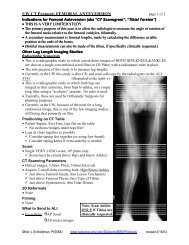Ankle and Foot 47 - Department of Radiology - University of ...
Ankle and Foot 47 - Department of Radiology - University of ...
Ankle and Foot 47 - Department of Radiology - University of ...
You also want an ePaper? Increase the reach of your titles
YUMPU automatically turns print PDFs into web optimized ePapers that Google loves.
<strong>47</strong> <strong>Ankle</strong> <strong>and</strong> <strong>Foot</strong> 2227 <strong>47</strong><br />
J K L<br />
M<br />
N<br />
Figure <strong>47</strong>-28, cont’d The marker (m) indicates the site <strong>of</strong> maximal tenderness. At this level, the PB is split into two pieces (black arrows),<br />
separated by the intact PL (white arrow). Oblique coronal T1-weighted (J), PD-weighted (K), <strong>and</strong> T2-weighted (L) images anterior to the LM,<br />
through the pain marker (m). All three sequences show increased signal in the PB (black arrow) as opposed to the normal black signal in the PL<br />
(white arrow). Although the “magic angle” can artifactually increase the intratendinous signal on the short TE sequences (T1 <strong>and</strong> PD), magic angle<br />
does not affect the long TE T2-weighted sequence. Thus, the bright signal in the PB on the T2-weighted image represents a true intrasubstance<br />
tear. The abnormal fluid in the common peroneal tendon sheath (white arrowhead) indicates active tenosynovitis. M <strong>and</strong> N, Far lateral sagittal<br />
inversion recovery images demonstrate the abnormal fluid in the common peroneal tendon sheath (white dotted rectangle) as well as the edema<br />
in the swollen PB (black dotted rectangle).<br />
Ch0<strong>47</strong>-A05375.indd 2227<br />
9/9/2008 5:33:56 PM
















